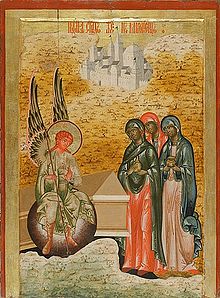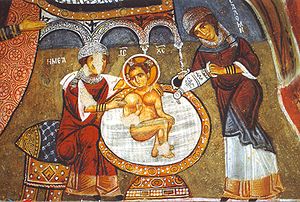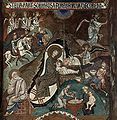- Salome (disciple)
-
Salome (Hebrew, "שלומית", "Shelomit"), sometimes venerated as Mary Salome, was a follower of Jesus who appears briefly in the canonical gospels and in more detail in apocryphal writings. She is sometimes identified as the wife of Zebedee, the mother of James and John, two of the Apostles of Jesus, and sometimes also as the sister of Mary, mother of Jesus.[1]
Contents
Salome's Name
"Salome" may be the Hellenized form of a Hebrew name, such as Shulamit, Shulamith, Shlomtsion or Shlomzion. A Queen called Salome in Josephus is known as Shlomzion in Hebrew sources. In Aramaic and in Arabic Salome is (سلمة Salma and Salomie سالومي ) which means peace.
Salome in the canonical gospels
In Mark 15:40, Salome is named as one of the women present at the crucifixion: "There were also women looking on afar off: among whom was Mary Magdalene, and Mary the mother of James the less and of Joses, and Salome".[2] The parallel passage of Matthew (27:56) reads thus: "Among which was Mary Magdalene, and Mary the mother of James and Joses, and the mother of Zebedee's children."[3] The Catholic Encyclopedia (1913) concludes that the Salome of Mark 15:40 is probably identical with the mother of the sons of Zebedee in Matthew; the latter is also mentioned in Matthew 20:20, in which she petitions Jesus to let her sons sit with him in Paradise.[4]
In John, three or perhaps four women are mentioned at the crucifixion; this time they are named as "his [Jesus'] mother, and his mother's sister, Mary the wife of Cleophas, and Mary Magdalene."[5] A common interpretation is to identify Salome as the sister of Jesus' mother, thus making her Jesus' aunt. In some places[citation needed] Salome is identified with Mary of Cleophas and venerated as "Saint Mary Salome". However, other traditional Catholic interpretations associate Mary of Cleophas with Mary the mother of James and Joses.
In the Gospel of Mark, Salome is among the women who went to Jesus' tomb to anoint his body with spices.[6] They discovered that the stone had been rolled away, and a figure in white then told them that Jesus had risen, and asked them to tell Jesus' disciples that he would meet them in Galilee. In Matthew, just two women are mentioned in the same story: Mary Magdalene and the somewhat ambiguous "other Mary".
The canonical gospels never go so far as to label Salome a "disciple", and so mainstream Christian writers usually describe her as a "follower" of Jesus.[citation needed]
Salome in the Apocrypha
The Gospel of Thomas found at Nag Hammadi mentions among the "disciples" of Jesus (the Greek expression "apostles" does not appear) two women, Salome and Mary Magdalene (referred to simply as "Mary").
The controversial Secret Gospel of Mark, that was referred to and quoted in the Mar Saba letter ascribed by his modern editors[7] to Clement of Alexandria, contains a further mention of Salome which is not present in the canonical Mark at 10.46. Clement quotes the passage in his letter: "Then he came into Jericho. And the sister of the young man whom Jesus loved was there with his mother and Salome, but Jesus would not receive them." The lines complete a well-known lacuna in Mark as the text currently stands.
In the early but non-canonical Greek Gospel of the Egyptians (early 2nd century), Salome appears again as a disciple of Jesus. She asks him how long death would hold sway, and he says to her, "So long as women bring forth, for I come to end the works of the female." To this Salome replies, "Then I have done well in not bringing forth." It would appear from this text that there was an early tradition that Salome the disciple was childless, and possibly unmarried.
In the Gospel of Thomas there is a reference to Jesus sharing Salome's couch at the meal, and of Salome's esoteric questioning. 'Who are you sir,' she asks him, 'that you have taken your place on my couch and eaten from my table?' And Jesus says, "I am he who is from the One, and the things that belong to the Father have been given to me." Salome replies, "But I am your disciple", and Jesus answers, "When the disciple is united he will be filled with light, but if he is divided he will be filled with darkness."
Even non-Christian writers in the 2nd century were aware that some tradition existed of secret teachings passed down from "Salome the disciple", to sects such as the Carpocratians, the followers of the Carpocrates who got hold of an unauthorized copy of the Secret Gospel of Mark in Alexandria mentioned in Clement's private letter and who claimed to derive some of their gnostic tenets from Salome, it would appear. A 2nd-century Greek, Celsus, wrote a True Discourse attacking the Christian sects as a threat to the Roman state. At the time he was writing, c. AD 178, the variety of Christian sects was still extremely broad. His treatise is lost, but quotes survive in the attack written somewhat later by Origen, Contra Celsum ("Against Celsus"): "While some of the Christians proclaim [that] they have the same god as do the Jews, others insist that there is another god higher than the creator-god and opposed to him. And some Christians teach that the Son came from this higher god. Still others admit of a third god - those, that is to say, who call themselves gnostics - and still others, though calling themselves Christians, want to live according to the laws of the Jews. I could also mention those who call themselves Simonians after Simon, and those naming themselves Helenians after Helen, his consort. There are Christian sects named after Marcellina, Harpocratian Christians who trace themselves to Salome, and some who follow Mariamne and others who follow Martha, and still others who call themselves Marcionites after their leader, Marcion."
Salome (right) as midwife, bathing the infant Jesus, is a common figure in Orthodox icons of the Nativity (fresco, XII c., "Dark Church", Open Air Museum, Goreme, Cappadocia.
In the early Christian texts there are several other references to "Salome". A midwife Salome appears in the infancy gospel attached to the name of James the Just, the Protevangelion of James, ch. XIV:
- "14 And the midwife went out from the cave, and Salome met her. 15 And the midwife said to her, "Salome, Salome, I will tell you a most surprising thing, which I saw. 16 A virgin has brought forth, which is a thing contrary to nature." 17 To which Salome replied, "As the Lord my God lives, unless I receive particular proof of this matter, I will not believe that a virgin has brought forth."
- 18 Then Salome went in, and the midwife said, "Mary, show yourself, for a great controversy has arisen about you." 19 And Salome tested her with her finger. 20 But her hand was withered, and she groaned bitterly, 21 and said, "Woe to me, because of my iniquity! For I have tempted the living God, and my hand is ready to drop off."
That Salome is the first, after the midwife, to bear witness to the Miraculous Birth and to recognize Jesus as the Christ, are circumstances that tend to connect her with Salome the disciple. By the High Middle Ages this Salome was often identified with Mary Salome in the West, and therefore regarded as the believing midwife.[8]
An apocryphal Coptic Book of the Resurrection of Christ, attributed to the apostle Bartholomew, names the women who went to the tomb. Among them were: Mary Magdalene; Mary the mother of James, whom Jesus delivered out of the hand of Satan; Mary who ministered to him; Martha her sister; Joanna (perhaps also Susanna) who renounced the marriage bed; and "Salome who tempted him".
Sainthood
She is commemorated in the Eastern Orthodox Church on the Sunday of the Myrrhbearers, i.e., the third Sunday of Pascha (Easter). Her feast day in the Latin rite of the Roman Catholic Church is October 22 [9] and in the Calendar of Saints of the Lutheran Church - Missouri Synod on August 3 with Joanna and Mary.
In art she is often portrayed with the Holy Family is paintings of the Holy Kinship.
See also
Gallery of art
References
- ^ "NETBible:Salome". http://net.bible.org/dictionary.php?word=salome.
- ^ Mark 15:40, King James Version. [1]
- ^ Matthew 27:56, King James Version. [2]
- ^
 "Salome". Catholic Encyclopedia. New York: Robert Appleton Company. 1913.
"Salome". Catholic Encyclopedia. New York: Robert Appleton Company. 1913. - ^ John 19:25, King James Version. [3]
- ^ "And when the sabbath was past, Mary Magdalene, and Mary the mother of James, and Salome, had bought sweet spices, that they might come and anoint him." Mark 16:1, King James Version. [4]
- ^ In 1980 the Mar Saba letter was included in the revision of the standard edition of works of Clement of Alexandria: Otto Stählin and Ursula Treu, Clemens Alexandrinus, vol. 4.1: Register, 2nd ed. (Berlin:Akademie-Verlag, 1980), XVII–XVIII.
- ^ G Schiller, Iconography of Christian Art, Vol. I,1971 (English trans from German), Lund Humphries, London, p.62, ISBN 853312702
- ^ Martyrologium Romanum (Libreria Editrice Vaticana 2001 ISBN 88-209-7210-7
Categories:- Followers of Jesus
- Saints from the Holy Land
- Eastern Orthodox saints
- People celebrated in the Lutheran liturgical calendar
- 1st-century Christian female saints
Wikimedia Foundation. 2010.






